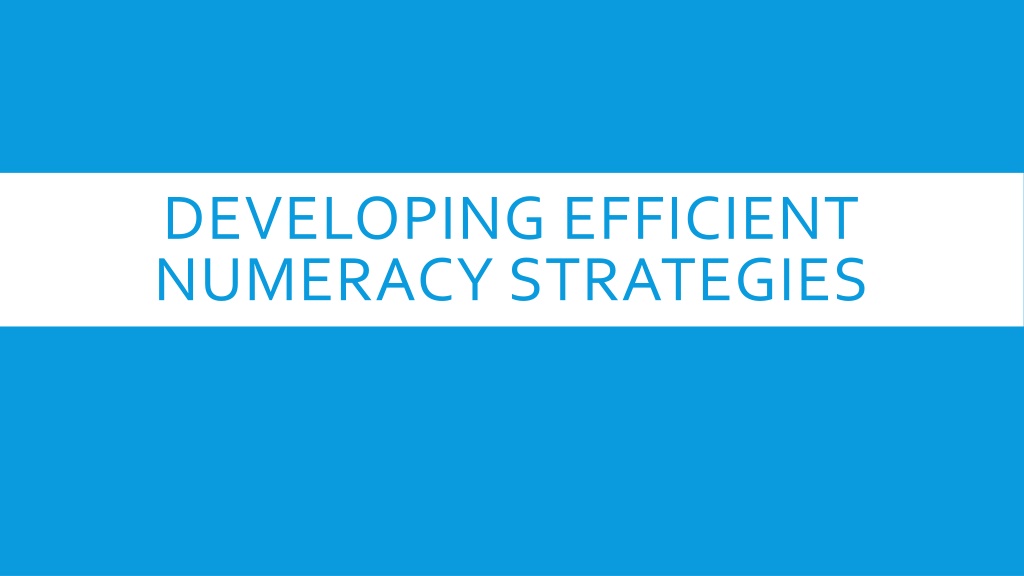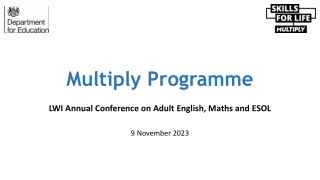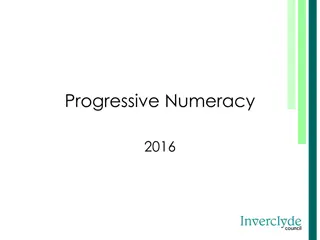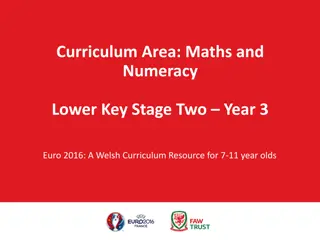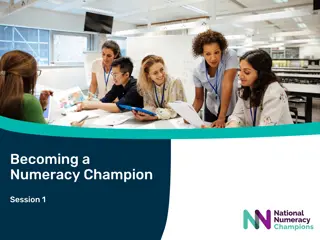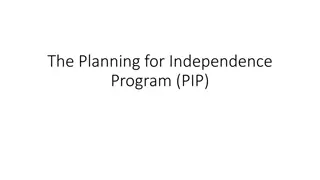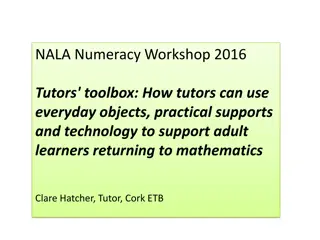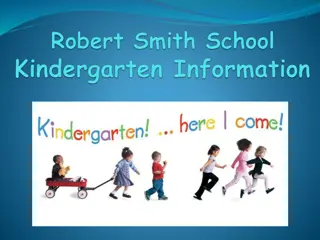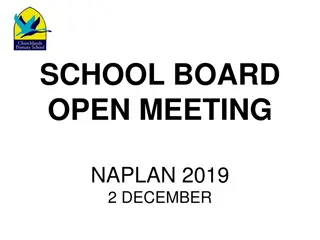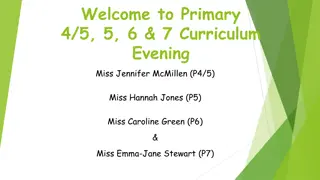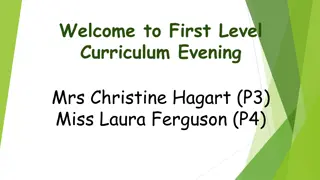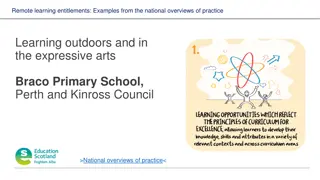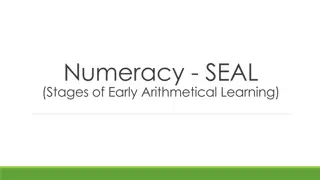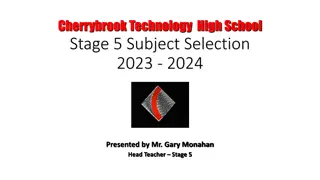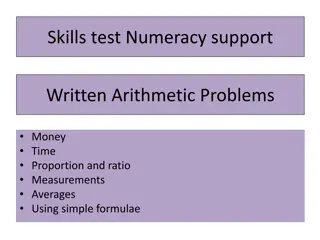Developing Efficient Numeracy Strategies for Students
Students employ diverse methods to solve number problems, from basic counting to advanced arithmetic strategies. An early numeracy project, "Count Me In Too," outlined a learning framework describing the progression of students' strategies. The Emergent Counting Stage focuses on basic number skills, while the Perceptual Counting Stage enhances counting abilities through various activities.
Download Presentation

Please find below an Image/Link to download the presentation.
The content on the website is provided AS IS for your information and personal use only. It may not be sold, licensed, or shared on other websites without obtaining consent from the author. Download presentation by click this link. If you encounter any issues during the download, it is possible that the publisher has removed the file from their server.
E N D
Presentation Transcript
DEVELOPING EFFICIENT NUMERACY STRATEGIES
DEVELOPING EFFICIENT NUMERACY STRATEGIES Students methods for solving number problems can be diverse, even in the early years of school. Counting is a surprisingly complex and powerful procedure. It begins from initial attempts to string together a sequence of numbers to using sophisticated strategies to solve addition, subtraction, multiplication and division problems. An early numeracy project was conducted in 1996 called Count me in too . It used a learning framework in number to support observations of children s strategies for solving arithmetic problems. The framework outlines how students move from using naive strategies to increasingly sophisticated strategies. It is used to sequence instruction.
1. EMERGENT COUNTING STAGE The nature of the learner Students may be able to: say some numbers and relate these to counting identify and name some numbers 0-10 (but not consistently). However, students are unable to: count forwards (or backwards) from 0 to 10 count items up to 1o objects Consistently match one number word to one item when counting.
1. EMERGENT COUNTING STAGE Students need to work on: counting collections identifying /naming numerals labelling collections. Activities: Egg carton drop/feather drop/paper cup drop Oral counting Dice games with ten frames Sequencing & identifying missing numbers, eg on a washing line Games involving matching groups of objects to numbers, egconcentration Guess the number/Higher or lower
2. PERCEPTUAL COUNTING STAGE The nature of the learner Students are able to: count things that they can see, hear or feel apply one-to one matching skills label collections of objects count by ones, always beginning at one provide the number before/after a given number (count by one to find it) They have a good understanding of numbers 1-10.
2. PERCEPTUAL COUNTING STAGE Students need to work on: adding two collections of objects counting without relying on concrete materials Subitising instant recognition of number dot patterns up to 10 consistently saying forward and backwards number sequences correctly teen numbers (reversals are very common) Activities: Oral counting to 20 (forwards and backwards & from a given number) Maths tipping game (state number before/after a given number) Teen number games, eg bingo, sequencing, missing numbers etc. Rabbits ears Dot flash/ Ten frame flash Rhythmic and skip counting
3 FIGURATIVE COUNTING STAGE The nature of the learner Students may be able to: Able to count things which are hidden. They don t need to see items to be able to count them. Use simple strategies such as counting by ones. Start from one to find the total. Orally count forwards and backwards from 0-20. Some may be able to go beyond this range. Give the number before and after a nominated number. Name numerals
3 FIGURATIVE COUNTING STAGE Students need to work on: Counting on to solve addition tasks. Counting back to solve subtraction tasks. Developing understanding of place value Activities: Bucket count on Counting objects in groups of ten How many am I hiding? Beat the Champ 2 Dice addition game What s my number?
4 COUNTING ON The nature of the learner Students may be able to: Use forward and backward counting to solve addition and subtraction problems The strategies of counting on and back are confidently used Recall some basic addition and subtraction facts For Example: Counting up from: Student counts forward from the larger number when finding the total Counting up to: Student counts up to find the difference between two numbers Counting down from: Student counts back from the larger number to solve subtraction problems
4 COUNTING ON Students need to work on Applying variety of strategies to solve mathematical problems Finding the total using skip counting Understanding place value eg. tens and ones Activities: Celebrity Head Skip counting chants and games eg. Buzz Dice games eg. 5 dice
5. FLEXIBLE (OR FACILE) The flexible or facile counting stage is characterised by using number properties combined with number facts. Flexible strategies are when a student uses the knowledge of number facts to solve a problem. A student may determine that 7 + 6 is 13 because double 6 is 12 and 7 + 6 is 1 more. Flexible strategies make use of the properties of numbers and do not employ counting by ones. For example, jump, split and compensation are flexible arithmetical strategies.
A USEFUL WEBSITE FOR ALL THINGS HOMEWORK Homework is an important part of learning, but sometimes parents find it hard to keep up with what needs to be done. Here is a range of resources to point you in the right direction. There are also some useful tips and help sheets to improve study skills in these areas. http://www.schoolatoz.nsw.edu.au/en/homework-and- study
SPLIT STRATEGY Mental computation method where numbers are 'split' into their place value to make it easier to add them. http://www.schoolatoz.nsw.edu.au/homework-and- study/maths/maths-a-to-z/- /maths_glossary/RId5/218/split+strategy
JUMP STRATEGY Mental calculation method jumping from one number (usually the largest number) either forwards (addition) or backwards (subtraction) to the answer. http://www.schoolatoz.nsw.edu.au/homework-and- study/maths/maths-a-to-z/- /maths_glossary/RId5/130/jump+strategy
COMPENSATION STRATEGY One number is rounded to simplify the calculation then the answer is adjusted to compensate for the original change. http://www.schoolatoz.nsw.edu.au/homework-and- study/maths/maths-a-to-z/- /maths_glossary/RId5/70/compensation+strategy
